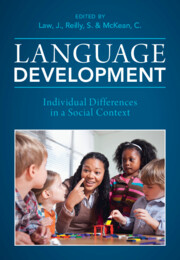Book contents
- Language Development
- Language Development
- Copyright page
- Contents
- Figures
- Tables
- Contributors
- A Tribute to Our Friend, Colleague and Fellow Editor, Professor James Law
- Introduction
- Part One Factors Influencing Language Development
- 3 Genetic Studies of Language Disorders
- 4 Hearing and Language
- 5 Co-occurrence between Language Disorders and Common Conditions in Childhood
- 6 Language and Cognition
- 7 Growing Up in Multilingual Communities
- 8 Parent–Child Interaction and Its Impact on Language Development
- 9 Cognitive Competencies and Signals of Risk
- 10 Creating Equitable Opportunities for Language and Literacy Development in Childhood and Adolescence
- Part Two Continuity and Change
- Part Three Impact, Intervention and Equity
- Index
- References
4 - Hearing and Language
from Part One - Factors Influencing Language Development
Published online by Cambridge University Press: 11 August 2022
- Language Development
- Language Development
- Copyright page
- Contents
- Figures
- Tables
- Contributors
- A Tribute to Our Friend, Colleague and Fellow Editor, Professor James Law
- Introduction
- Part One Factors Influencing Language Development
- 3 Genetic Studies of Language Disorders
- 4 Hearing and Language
- 5 Co-occurrence between Language Disorders and Common Conditions in Childhood
- 6 Language and Cognition
- 7 Growing Up in Multilingual Communities
- 8 Parent–Child Interaction and Its Impact on Language Development
- 9 Cognitive Competencies and Signals of Risk
- 10 Creating Equitable Opportunities for Language and Literacy Development in Childhood and Adolescence
- Part Two Continuity and Change
- Part Three Impact, Intervention and Equity
- Index
- References
Summary
Acquiring spoken language is generally quite an effortless process for children who can hear. However, children with hearing loss may experience greater difficulties in supporting their spoken language development. This chapter explores how hearing influences spoken language learning, reviewing the impact of health initiatives, such as universal newborn hearing screening, on lowering the age at detection of congenital hearing loss. Results from large population-based studies highlight how earlier intervention and provision of amplification (hearing aids or cochlear implants) improves language outcomes of children with permanent, sensorineural hearing losses, but outcomes on average still lag those of their peers with normal hearing. General agreement in the literature around permanent hearing losses contrasts with the lack of evidence on the consequences of conductive hearing loss. Most knowledge is drawn from clinical studies of children with otitis media with effusion and examines speech and language outcomes in this context. The auditory system and speech and language abilities seem to recover with age, but there is no consensus on the impact on more discrete abilities. Here, factors impacting language outcomes and the language learning environment are discussed in the context of hearing loss.
Keywords
- Type
- Chapter
- Information
- Language DevelopmentIndividual Differences in a Social Context, pp. 78 - 99Publisher: Cambridge University PressPrint publication year: 2022

